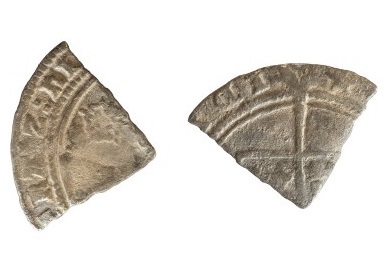Edward VI sixpence

The coin fragment, both sides

Entire sixpence, from the internet
This incomplete 16th century silver coin was found in the Lincolnshire Wolds, not far from Louth. The experts of the Portable Antiquities Scheme tell us that it is a sixpence, minted in York, and dates from the third period of the reign of King Edward VI. It’s only little: this piece is 1.6 cm long and weighs 0.75 g.
Edward VI was the “Boy King”, the only surviving son of Henry VIII, who reigned from 1547 (age 9) until his death in 1553 (age15). The name King Edward VI is familiar to residents of Louth. Our grammar school can trace its history back to the 13th century but was re-established in 1551 under the Charter of King Edward VI. The school is still known as King Edward VI Grammar School, and you can see a statue of the boy king in Schoolhouse Lane.
Coins issued during the short reign of King Edward VI (1547-1553), can be classified into three distinct periods. Initially there was a continuation of the coinage used under Henry VIII; the second period introduced base coinage with Edward VI's name and portrait; and in the third period (1550-1553) high quality silver coins were issued, a significant departure from the previous base metal coins. At this time coins were made using the "hammered" method, where blank metal discs were struck between two dies, one for the obverse and one for the reverse, using a hammer.
Our silver coin is worn and only one quarter survives. You might be tempted to think, as I did initially, that this coin had been cut so that its value was reduced to one quarter of sixpence. Coin clipping was relatively common in the 17th century. Shavings from the outside of the coin were saved up and melted into bullion or used to make new coins. Our incomplete sixpence is very different. The experts say that the breaks are straight but uneven, and the coin was not deliberately cut.
Sixpence was a significant amount of money, about a day’s wages. The owner of this coin would have been gutted to lose it. But because it was lost, it was not destroyed in the Great Recoinage of 1696 when the government recalled all old coins and offered to refund them at face value, regardless of how much had been clipped off. The old coins were melted down at the Royal Mint, and new coins had milled edges to prevent further clipping.
This incomplete sixpence was kindly given to us by metal detectorist Richard Seth and the landowner, and will be on display in Louth Museum in 2026.